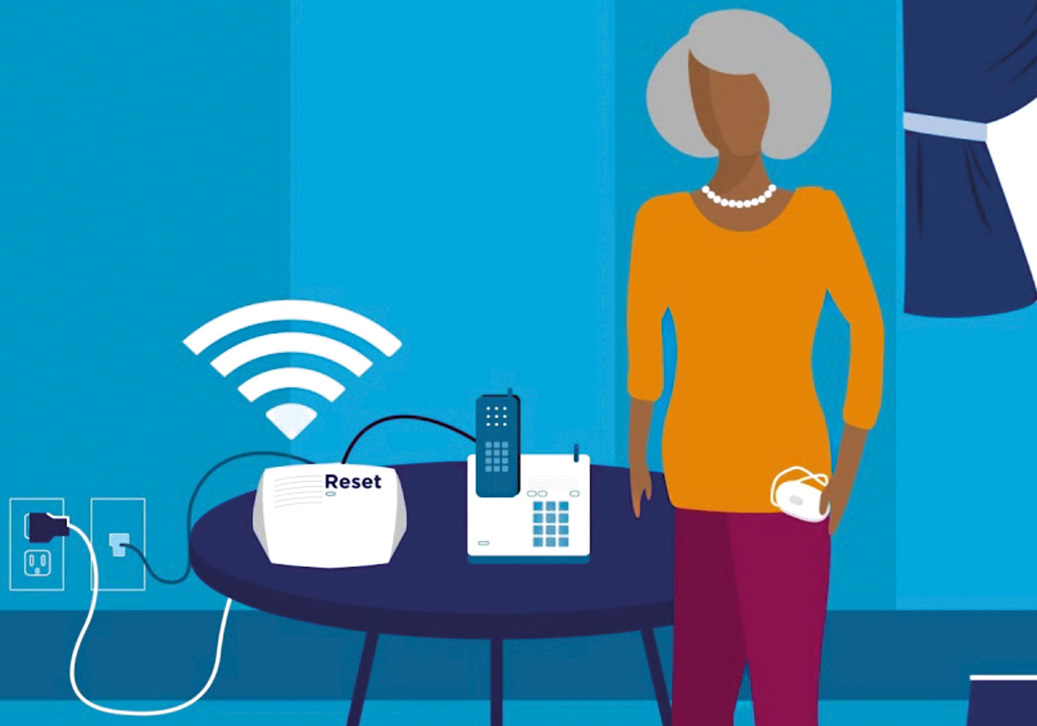By Marc Saltzman
It goes by different names,“independent living,” non-assisted living” or the preferred “aging in place.” But they all mean the same thing: Growing older without having to move to a health care environment.
In fact, 91 per cent of seniors say they want to stay in their own homes as they age, according to a recent survey of Canadian boomers commissioned by RBC.
Today, high-tech monitoring systems and other gadgets are helping seniors age in place independently, while giving family members peace of mind in the process. What’s more, home-based tech tools could be far less expensive than moving into an assisted living environment.
The following is a look at some of the main “aging in place” tech categories, and an example of a service for each.
Emergency pendants, smartwatches
Worn around the wrist or neck, an emergency pendant can be pressed in case of an emergency, such as after a fall, and a call is immediately made to 911 and/or the pre-programmed numbers of family members.
Features vary- for example, some work outside, others offer two-way voice support and some have a “fall detection” feature so loved ones are notified even if a senior isn’t able to press the button.
With their lightweight and waterproof designs, Philips Lifeline products are some of the more popular solutions on the market: HomeSafe with AutoAlert fall detection works at home, while the GoSafe pendant (with AutoAlert and two-way voice) uses up to six locating technologies, including GPS, to find someone in an emergency.
HomeSafe with AutoAlert starts at $36/month for the landline version or $43/month if you don’t have a home phone. The mobile GoSafe option cost $75/month for the landline version or $80/month for the wireless option, along with a one-time $89 device fee.
Apple Watch Series 4 (from $519) also has some impressive features that are ideal for at-home seniors. As with its predecessors, these smartwatches offer a gorgeous waterproof screen, Siri voice support, fitness detection and optional cellular connectivity (for an extra $10/month with your carrier), but for the first time there’s a built-in electrocardiogram to complement the existing heart-rate monitor, which can detect a dangerously high or low heart rate, or an irregular heart rhythm (arrhythmia).
What’s more, Apple Watch now offers fall detection and an Emergency SOS feature, which can call 911 and notify your emergency contacts if it detects a sudden drop.
Sensors
Rather than calling your loved ones several times a day to check in, activity-based sensors around the home can discretely reassure you they’re up and going about their daily business. If not, a remote family member, caregiver or emergency response service is alerted—via phone, e-mail or text message—if an at-risk elderly person is doing (or not doing) something. For example, it can detect if a senior hasn’t left their bedroom at their usual time or if they haven’t opened the fridge door or medicine cabinet in, say, five hours. Installation, which is usually handled by a professional, is often folded into the monitoring cost.
One such choice is Alarm.com’s Wellness independent living solution, which integrates a suite of sensors and devices, and applies machine-learning algorithms to the data they generate to proactively detect changes that may suggest risks. Wellness can report about changes in activity levels, sleeping and eating patterns, bathroom visit frequency and medication adherence, as well as emergency situations such as wandering out of the home or falls. Less intrusive (and frankly, smarter) than video cameras, sensors can go on doors, windows, cabinets, chairs, under bed sheets and so on.
Coupled with Alarm.com’s home security solution, Wellness is about $50/month, after installation costs, but pricing depends on the service provider and the exact mix of devices and sensors.

Medication reminders, dispensers
It’s a potentially dangerous scenario for many seniors: you’re on medication but you forget to take it—or worse, you can’t remember whether you took your pills or not, so you take them again. This problem has attracted lots of innovation over the past few years, and a handful of products have been designed to remind, dispense and/or manage medication.
With the e-pill MedTime Station ($289), for example, seniors will hear an alarm and see a flashing light when it is time to take medication. Located in a tray inside the device, the pills rotate into position. Ideal for those with dexterity challenges, simply pull the blue handle forward and the medication falls into a provided stainless-steel medicine cup, and the alarm automatically turns off. The lockable automatic pill dispenser can dispense medication up to six times per day.
Also with an alarm and flashing light, the e-pill MedSmart Automatic Pill Dispenser with Patient Compliance Dashboard ($489), on the other hand, has a higher pill capacity (20 aspirin-sized pills) and includes an LCD screen that shows the date, time, next dose scheduled, doses remaining and battery level. Along with additional alarm settings, the automatic pill dispenser has an auto-lock dispensing door that only allows access to the medication tray at the scheduled dosage time. There are no monthly fees for any of the e-pill solutions.
And then there’s e-pill’s MedSmart PLUS ($789) pill dispenser, which has all the features of the e-pill MedSmart Automatic Pill Dispenser with Patient Compliance Dashboard, but also adds free lifetime monitoring. This automatically calls a remote caregiver’s phone or sends a text message or e-mail notification if medications have not been taken within 60 minutes of the scheduled alarm time (works in Canada and the US).

Video cameras
Video chatting—via a camera on a smartphone, tablet, laptop or desktop computer’s webcam—is great way to communicate, consensually, with your aging relatives. In fact, compared to a regular phone call, video can be a much more effective way for caregivers to gauge how the senior is doing, based on how they look or act or the state of their home in the background. A picture, as they say, is worth a thousand words.
Services such as Skype or FaceTime work on multiple devices (although FaceTime is limited to Apple’s products) and do not cost anything when used over Wi-Fi connectivity with other Skype or FaceTime users. Often, younger and/or more tech-savvy family members can set the senior up with an account and show them how to place and accept a video call.
Many seniors enjoy having a virtual “face-to-face” meal with a friend or relative on a daily or weekly basis. Of course, there are also more robust video services available, including those that support multiple cameras, real-time monitoring and so on.

Smart speakers, screens
Technology is getting a lot easier to access—including for those with dexterity challenges—thanks in part to the popularity of “smart speakers” and “smart displays.” Just like talking to another person, it’s your voice that’s powering these new “digital assistants,” which are transforming the way we do many things in the home.
When connected to your home’s Wi-Fi, voice-activated personal assistants—such as Amazon Echo ($129) and Google Home ($179)—are smart speakers with a sensitive microphone you can place somewhere you hang out a lot in the home, such as in a kitchen. After saying the wake words—“OK Google” for Google Home, or “Alexa” for Amazon Echo—you simply ask a question or give a command, and you’ll hear a human-like female voice respond.
Ask to hear the news, a specific song, a podcast or a joke. Or set a timer for the oven, turn the lights on outside, order an Uber or learn a new language with audio-based lessons.

These devices can help you remember where you left things. Say something like “Remember my passport is in the top drawer.” When you need it in the future, ask “Where’s my passport?” and “she” will tell you where it is. With hands-free calling, you can ask to call friends, family and businesses using just your voice—and it doesn’t cost anything to call Canadian or US numbers.
Smart assistants are being integrated into many other Wi-Fi products in the home, too, such as televisions, Wi-Fi thermostats and even appliances. “Smart displays” are also becoming trendy. As the name suggests, these are small devices that not only have a speaker and microphone, but also a touchscreen and camera. So now, when you give it instructions, along with getting a human-like voice responding to you, you’ll also see info on the screen, such as a multi-day weather forecast, recipe, photos, a YouTube video or album art for your streaming music. You can make free video calls, too, thanks to the camera.
Marc Saltzman is a recognized expert in computers, consumer electronics, internet trends, and small business technology. You can see him on CNN, CTV, Global TV, and on Cineplex movie theatre screens across Canada. Follow him on Twitter @marc_saltzman.












